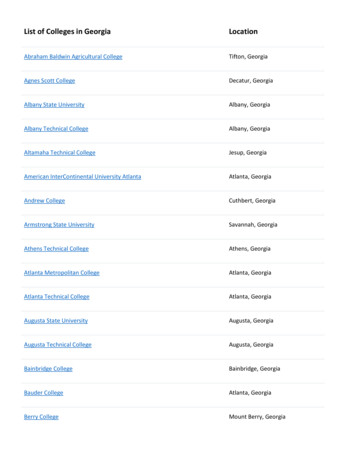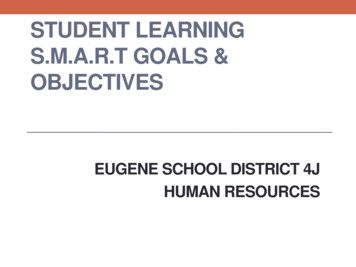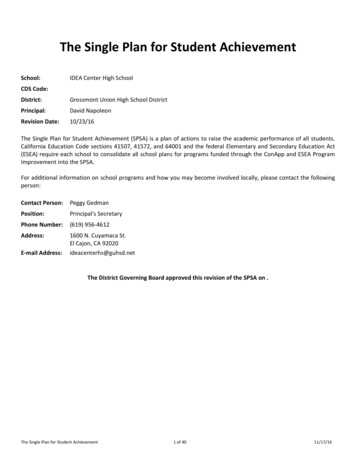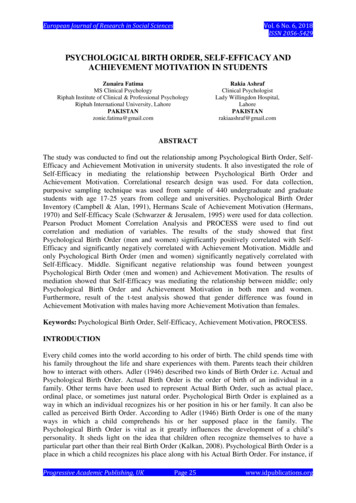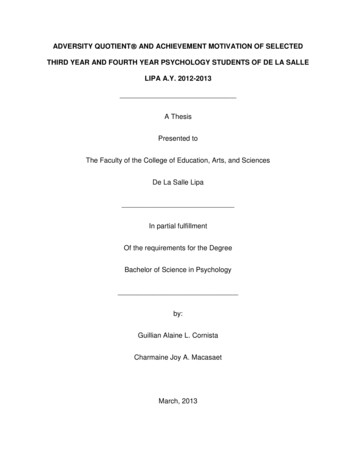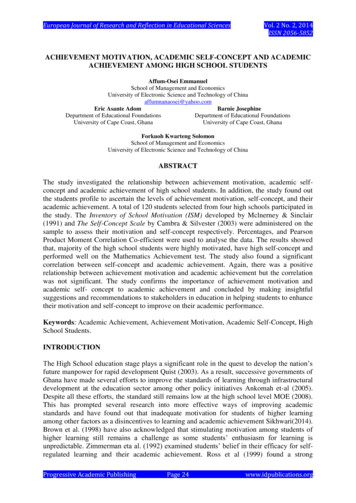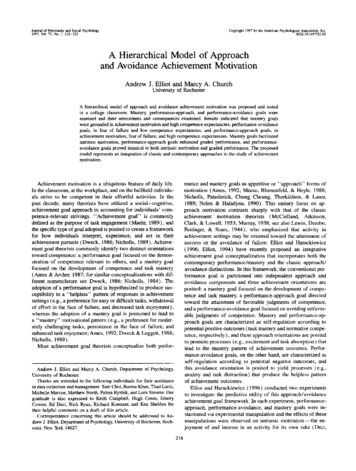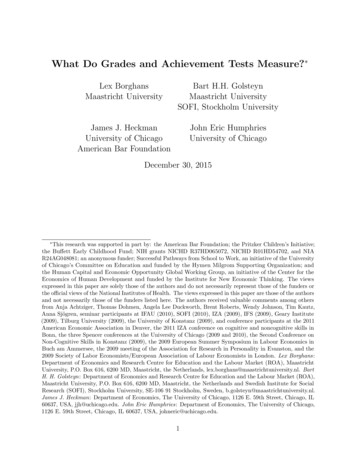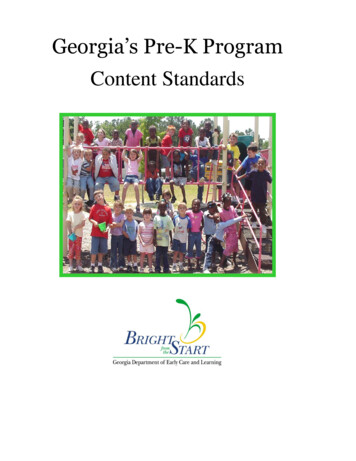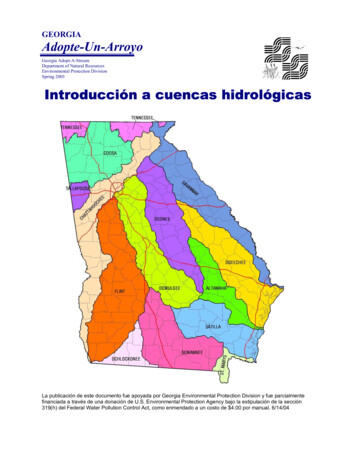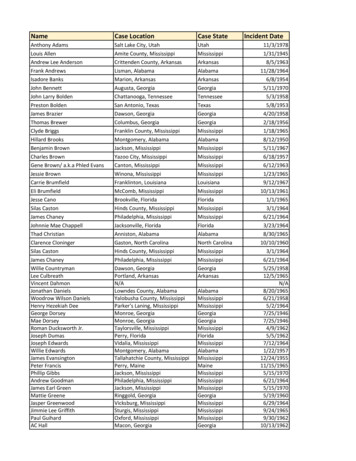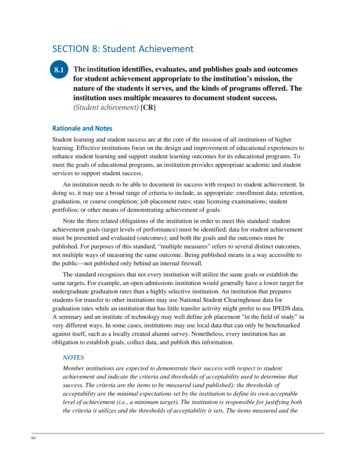
Transcription
SECTION 8: Student Achievement8.1The institution identifies, evaluates, and publishes goals and outcomesfor student achievement appropriate to the institution’s mission, thenature of the students it serves, and the kinds of programs offered. Theinstitution uses multiple measures to document student success.(Student achievement) [CR]Rationale and NotesStudent learning and student success are at the core of the mission of all institutions of higherlearning. Effective institutions focus on the design and improvement of educational experiences toenhance student learning and support student learning outcomes for its educational programs. Tomeet the goals of educational programs, an institution provides appropriate academic and studentservices to support student success.An institution needs to be able to document its success with respect to student achievement. Indoing so, it may use a broad range of criteria to include, as appropriate: enrollment data; retention,graduation, or course completion; job placement rates; state licensing examinations; studentportfolios; or other means of demonstrating achievement of goals.Note the three related obligations of the institution in order to meet this standard: studentachievement goals (target levels of performance) must be identified; data for student achievementmust be presented and evaluated (outcomes); and both the goals and the outcomes must bepublished. For purposes of this standard, “multiple measures” refers to several distinct outcomes,not multiple ways of measuring the same outcome. Being published means in a way accessible tothe public—not published only behind an internal firewall.The standard recognizes that not every institution will utilize the same goals or establish thesame targets. For example, an open-admissions institution would generally have a lower target forundergraduate graduation rates than a highly selective institution. An institution that preparesstudents for transfer to other institutions may use National Student Clearinghouse data forgraduation rates while an institution that has little transfer activity might prefer to use IPEDS data.A seminary and an institute of technology may well define job placement “in the field of study” invery different ways. In some cases, institutions may use local data that can only be benchmarkedagainst itself, such as a locally created alumni survey. Nonetheless, every institution has anobligation to establish goals, collect data, and publish this information.NOTESMember institutions are expected to demonstrate their success with respect to studentachievement and indicate the criteria and thresholds of acceptability used to determine thatsuccess. The criteria are the items to be measured (and published); the thresholds ofacceptability are the minimal expectations set by the institution to define its own acceptablelevel of achievement (i.e., a minimum target). The institution is responsible for justifying boththe criteria it utilizes and the thresholds of acceptability it sets. The items measured and the64
thresholds of acceptability should be consistent with the institution’s mission and the studentsit serves.In their reviews, SACSCOC committees will examine and analyze (1) documentationdemonstrating success with respect to student achievement, (2) the appropriateness of criteriaand thresholds of acceptability used to determine student achievement, and (3) whether thedata and other information to document student achievement is appropriately published.While this standard does not ask what the institution does when it finds it falls short of itsown expectations, institutions not meeting their self-identified thresholds of performancewould be expected to document efforts to meet expectations. (See especially Standard 7.1[Institutional planning], as well as Standard 7.2 [Quality Enhancement Plan], Standard 8.2.a[Student outcomes: educational programs], Standard 8.2.b [Student outcomes: generaleducation], and Standard 8.2.c [Student outcomes: academic and student services].)The Interpretation of Core Requirement 8.1 (Student achievement) also requires memberinstitutions to identify a graduation rate metric with SACSCOC; institutions may not designatea new indicator until their subsequent reaffirmation cycle. Institutions which are preparing acompliance certification for review during the reaffirmation process or review by a Fifth-YearInterim Committee to address graduation rates – using that chosen indicator – whenproviding a narrative and supporting documentation for this standard. Institutions whosegraduation rates fall below appropriate and acceptable institutional targets should alsodiscuss ongoing institutional strategies to seek improvement. Institutions which only servegraduate and professional students were not asked to select an indicator for SACSCOC; theyare, however, expected to address graduation rate as part of their discussion of studentachievement.In order to maximize institutional effectiveness in the area of student achievement,member institutions should also disaggregate graduation rate data by appropriate gender,ethnic, socioeconomic, and/or other student population characteristics. Institutions should, asa result of the analysis of such disaggregated data, discuss any ongoing institutionalstrategies to seek improvement in the achievement of at-risk student populations whenaddressing compliance with this standard. The institution will also be expected to provide arationale for the way(s) in which it disaggregates graduation rate data.Questions to Consider How does the institution determine appropriate measurable goals and outcomes for studentachievement consistent with its mission? Does a state board or specialized accreditor expect certain student achievement rates thatwould be relevant for this standard? Are data sources for this information clearly identified? If the institution does not use examples of criteria mentioned above, what are the criteria usedand why are they appropriate? Are both criteria and thresholds of acceptability clearly identified?Resource Manual for The Principles of Accreditation: Foundations for Quality Enhancement65
Can the institution justify both criteria and thresholds of acceptability that would be foundacceptable by a reasonable external party? How does the institution publish this information for the public?Sample Documentation Published evidence containing tables, charts, and/or narrative that include criteria, thresholdsof acceptability, and findings related to student achievement. Discussion of the underlying rationale for the chosen criteria and thresholds in relation to theinstitution’s mission. Data underlying the findings.Reference to SACSCOC Documents, If ApplicableSACSCOC policy:Institutional Obligations for Public DisclosureSACSCOC interpretation:Interpretation of Core Requirement 8.1 (Student achievement)Cross-References to Other Related Standards/Requirements, If ApplicableCR 7.1Standard 7.2Standard 8.2.aStandard 8.2.bStandard 8.2.c8.2(Institutional planning)(Quality Enhancement Plan)(Student outcomes: educational programs)(Student outcomes: general education)(Student outcomes: academic and student services)The institution identifies expected outcomes, assesses the extent to whichit achieves these outcomes, and provides evidence of seekingimprovement based on analysis of the results in the areas below:a.Student learning outcomes for each of its educational programs.(Student outcomes: educational programs)b.Student learning outcomes for collegiate-level general educationcompetencies of its undergraduate degree programs.(Student outcomes: general education)c.Academic and student services that support student success.(Student outcomes: academic and student services)Rationale and NotesStudent outcomes—both within the classroom and outside of the classroom—are the heart of thehigher education experience. Effective institutions focus on the design and improvement of66
educational experiences to enhance student learning and support appropriate student outcomes forits educational programs and related academic and student services that support student success.To meet the goals of educational programs, an institution is always asking itself whether it has metthose goals and how it can become even better.Even though the concept of institutional effectiveness may not be explicitly referenced in allof the standards, the accreditation process assumes that all programs and services, whereveroffered within the context of the institution’s mission and activity, are reviewed as part of theinstitutional effectiveness process.When reviewing this standard, peer evaluators will look for evidence of each of the three keyelements of the standard, but do so as an integrated activity where the parts are linked. Whenreporting about the process, it might be useful to consider the process in this fashion:While the standard emphasizes the three points on the left of the graphic, a thoroughexplanation of the process will also describe the processes on the right side of the graphic. Theinstitution will not be able to show effective assessment of its outcomes if its means of assessmentdo not measure what it has set forth as its expected outcomes. Likewise, if the assessment findingsare not somehow analyzed or evaluated, it will be hard to show the linkage between undertakingassessments and the continuous improvement of programs and services. Finally, this is a process,and the underlying expectation is that it is ongoing.NOTESIf there are commonalities in the process by which institutions use student outcomesassessment for institutional improvement across the three elements of this standard, theinstitution may want to prepare a single preface that could be referenced or hyperlinked fromeach substandard that outlines the process (organizational structure, timetables, localresources, internal review, etc.). However, review committees will make a separatedetermination of compliance on each substandard. Because components of the process maydiffer for each part of the standard, additional content in this Manual will be presentedseparately for each substandard.Effective outcomes assessment can be achieved in a variety of ways, and the mentality that“one size fits all” is inappropriate and diminishes the individual missions of institutions. Thisis especially true regarding the use of language to describe processes; for example,“assessment,” “evaluation,” “goals,” “outcomes,” and “objectives” may have preciseResource Manual for The Principles of Accreditation: Foundations for Quality Enhancement67
meaning to a reviewer, but the institution may have a meaningful effectiveness system even ifit is not as precise with its language as the reviewer would like. The institution should developand/or use methods and instruments that are uniquely suited to its circumstances, and aresupported by its faculty and its academic and student support professionals.At the time of its review, the institution is responsible for demonstrating that the full cycleoutlined above has taken place, and that the current process is being used to promotecontinuous improvement. For institutions that do not use annual reporting, sufficient cycles ofreporting should be provided to establish that the process is applied to all educationalprograms.At the time of its review, the institution is responsible for providing evidence of “seekingimprovement.” The institution should be using the data to inform changes based on evaluationof its findings. Plans to make improvements do not qualify as seeking improvement, but effortsto improve a program that may not have been entirely successful certainly do.NOTE ON SAMPLINGThere is an expectation that an institution is able to demonstrate institutional effectiveness forall its educational programs and related academic and student services. The volume ofmaterial represented by this activity can be quite large, especially at larger institutions. Tothis end, an institution may provide a sampling of the effectiveness of its programs at the timeof its comprehensive review. Sampling, for the purpose of accreditation, includes thefollowing three elements:(1) A representation that is mindful of the institution’s mission.(2) A valid cross-section of programs from every school or division (and across all levels),with every major division and level of program represented. Sampling should be inclusiveof off-campus sites and distance or correspondence education offerings, as applicable; ata minimum, the institution should clarify that assessment activities are inclusive of thesemodes of delivery and explain that process.(3) A compelling case – presented in the institution’s narrative – as to why the sampling andassessment findings are an appropriate representation of the institution’s educationalprograms and its academic and student support services. Sampling does not preclude theinstitution from having effectiveness data/analysis available on all programs and units. Itis the prerogative of a SACSCOC committee to conduct a more in-depth review of aninstitution’s data/findings/analysis on the effectiveness of all its educational programs andits academic and student support services.68
The institution identifies expected outcomes, assesses the extent to which8.2.a it achieves these outcomes, and provides evidence of seeking improvementbased on analysis of the results for student learning outcomes for each ofits educational programs. (Student outcomes: educational programs)Rationale and NotesFor purposes of this standard, an academic program is a credential as defined by the institution. Adegree with a defined major is clearly a program. On the other hand, programs in the same fieldbut taught at different levels (e.g., a BBA and an MBA) are typically viewed as distinct programs.The Institutional Summary Form Prepared for SACSCOC Reviews should be a useful guide as tohow programs are defined within this standard.The expectation is that the institution will engage in ongoing planning and assessment toensure that for each academic program, the institution develops and assesses expected studentlearning outcomes. Expected student learning outcomes specify the knowledge, skills, values, andattitudes students are expected to attain in courses or in a program. Methods for assessing theextent to which students achieve these outcomes are appropriate to the nature of the discipline andconsistent over time to enable the institution to evaluate cohorts of students who complete coursesor a program.Shared widely within and across programs, the results of this assessment can affirm theinstitution’s success at achieving its mission and can be used to inform decisions about curricularand programmatic revisions. At appropriate intervals, program and learning outcomes andassessment methods are evaluated and revised.NOTESee the Standard 8.2 discussion as well as this substandard for full coverage of this standardwithin the Resource Manual.Questions to Consider Is there a common process across programs at the institution, or is the means of establishingoutcomes assessment processes widely dispersed? If the latter, how is information collectedand evaluated? What is the role of faculty, chairs, deans, oversight committees and others in the process? Is the process systematic and ongoing? Are expected student learning outcomes clearly defined in measurable terms for eacheducational program? What types of assessment activities occur to determine whether learning outcomes are met? How are results from periodic assessment activities analyzed? How does the institution seek improvements in educational programs after conducting theseanalyses?Resource Manual for The Principles of Accreditation: Foundations for Quality Enhancement69
If programs consistently report “no improvements needed,” what happens? If the institution used sampling to present its process and to establish compliance with thestandard, why were the sampled programs an appropriate representation of all the institution’sprograms? Were multiple assessment methods used? If so, describe. How has the institution’s use of assessment results improved educational programs?Sample Documentation Lists of program-specific expected student learning outcomes for educational programs(usually embedded into individual program or unit reports). Descriptions of the assessment measures used to collect information on student learning. Details on the assessment and analysis of results from these assessments. Specific examples where the findings from analysis of results have led to efforts to makeprogram improvements. If sampling is used, (1) how the sampling is representative of the institution’s mission, (2)documentation of a valid cross-section of programs, and (3) make a case as to why samplingand assessment findings are an appropriate representation of the institution’s programs.Reference to SACSCOC Documents, If ApplicableSACSCOC policy:Distance and Correspondence EducationSACSCOC interpretation:Interpretation on SamplingInterpretation of Standard 8.2.aCross-References to Other Related Standards/Requirements, If Applicable70CR 7.1(Institutional planning)Standard 7.2(Quality Enhancement Plan)CR 8.1(Student achievement)
a. Student learning outcomes for each of its educational programs. (Student outcomes: educational programs) b. Student learning outcomes for collegiate-level general education competencies of its undergraduate degree programs. (Student outcomes: general education) c. Academicand student services that support student success.
